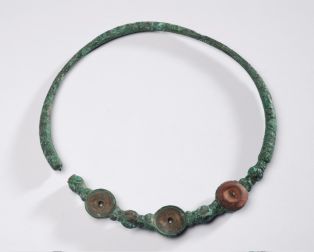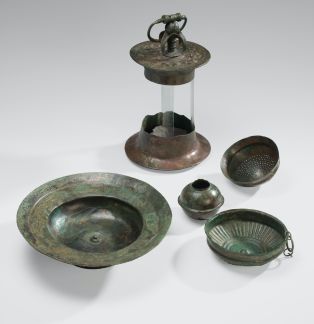Oeuvre : Précisions - coupe à pied | Musée Unterlinden |



Domaine :
Dénomination :
Millésime de l'oeuvre :
700 av JC entre ; 600 av JC et
Epoque - Style :
Technique et matériaux :
Dimensions :
H. 7 cm ; D. 26,4 cm
Genèse :
Numéro d'inventaire :
61.230
Date d'acquisition :
1961
Bibliographies :
Auteur de l'image :
Commentaire :
La coupe à pied était probablement destinée à la consommation de boissons. Fabriquée à partir d’une fine tôle martelée, elle est constituée de deux éléments, un pied creux et une coupe au bord large, réunis par un rivet imposant.
Il s’agit d’un modèle que l’on retrouve fréquemment dans la nécropole du site autrichien de Hallstatt. Ce type de coupe apparaît au 7e siècle avant notre ère dans les tombes d’Allemagne du sud et d’Autriche.
Die Schale mit Standring war sehr wahrscheinlich zum Verzehr von Getränken bestimmt. Sie ist aus dünn getriebenem Blech gefertigt und besteht aus zwei Teilen: einem Standring und einer Schale mit breitem Rand, die durch eine breite Niete miteinander verbunden sind.
Schalen dieses Typs finden sich häufig in der Nekropole im österreichischen Hallstatt. Ab dem 7. Jahrhundert v.u.Z. tauchen sie in Gräbern in Süddeutschland und anderen Regionen Österreichs auf.
The footed bowl was probably used for the consumption of drinks. Made from thin hammered sheet metal, it consists of two elements, a hollow foot and a broad-rimmed bowl, joined by an imposing rivet.
It is an example of a design frequently found in the necropolis at the Austrian site of Hallstatt. This type of bowl appeared in the 7th century BCE in the tombs of southern Germany and Austria.
Il s’agit d’un modèle que l’on retrouve fréquemment dans la nécropole du site autrichien de Hallstatt. Ce type de coupe apparaît au 7e siècle avant notre ère dans les tombes d’Allemagne du sud et d’Autriche.
Die Schale mit Standring war sehr wahrscheinlich zum Verzehr von Getränken bestimmt. Sie ist aus dünn getriebenem Blech gefertigt und besteht aus zwei Teilen: einem Standring und einer Schale mit breitem Rand, die durch eine breite Niete miteinander verbunden sind.
Schalen dieses Typs finden sich häufig in der Nekropole im österreichischen Hallstatt. Ab dem 7. Jahrhundert v.u.Z. tauchen sie in Gräbern in Süddeutschland und anderen Regionen Österreichs auf.
The footed bowl was probably used for the consumption of drinks. Made from thin hammered sheet metal, it consists of two elements, a hollow foot and a broad-rimmed bowl, joined by an imposing rivet.
It is an example of a design frequently found in the necropolis at the Austrian site of Hallstatt. This type of bowl appeared in the 7th century BCE in the tombs of southern Germany and Austria.



 Copyright© WebMuseo 2019 - 2024
Copyright© WebMuseo 2019 - 2024